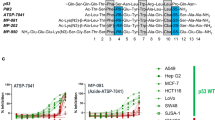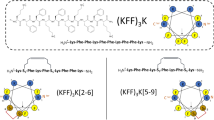Abstract
Hydrocarbon-stapled peptides are a class of bioactive alpha-helical ligands developed to dissect and target protein interactions. While there is consensus that stapled peptides can be effective chemical tools for investigating protein regulation, their broader utility for therapeutic modulation of intracellular interactions remains an active area of study. In particular, the design principles for generating cell-permeable stapled peptides are empiric, yet consistent intracellular access is essential to in vivo application. Here, we used an unbiased statistical approach to determine which biophysical parameters dictate the uptake of stapled-peptide libraries. We found that staple placement at the amphipathic boundary combined with optimal hydrophobic and helical content are the key drivers of cellular uptake, whereas excess hydrophobicity and positive charge at isolated amino acid positions can trigger membrane lysis at elevated peptide dosing. Our results provide a design roadmap for maximizing the potential to generate cell-permeable stapled peptides with on-mechanism cellular activity.
This is a preview of subscription content, access via your institution
Access options
Subscribe to this journal
Receive 12 print issues and online access
$259.00 per year
only $21.58 per issue
Buy this article
- Purchase on Springer Link
- Instant access to full article PDF
Prices may be subject to local taxes which are calculated during checkout






Similar content being viewed by others
References
Walensky, L.D. & Bird, G.H. Hydrocarbon-stapled peptides: principles, practice, and progress. J. Med. Chem. 57, 6275–6288 (2014).
Schafmeister, C.E., Po, J. & Verdine, G.L. An all-hydrocarbon cross-linking system for enhancing the helicity and metabolic stability of peptides. J. Am. Chem. Soc. 122, 5891–5892 (2000).
Walensky, L.D. et al. Activation of apoptosis in vivo by a hydrocarbon-stapled BH3 helix. Science 305, 1466–1470 (2004).
Bernal, F., Tyler, A.F., Korsmeyer, S.J., Walensky, L.D. & Verdine, G.L. Reactivation of the p53 tumor suppressor pathway by a stapled p53 peptide. J. Am. Chem. Soc. 129, 2456–2457 (2007).
Bernal, F. et al. A stapled p53 helix overcomes HDMX-mediated suppression of p53. Cancer Cell 18, 411–422 (2010).
Chang, Y.S. et al. Stapled α-helical peptide drug development: a potent dual inhibitor of MDM2 and MDMX for p53-dependent cancer therapy. Proc. Natl. Acad. Sci. USA 110, E3445–E3454 (2013).
Barclay, L.A. et al. Inhibition of pro-apoptotic BAX by a noncanonical interaction mechanism. Mol. Cell 57, 873–886 (2015).
Gavathiotis, E. et al. BAX activation is initiated at a novel interaction site. Nature 455, 1076–1081 (2008).
Kim, W. et al. Targeted disruption of the EZH2-EED complex inhibits EZH2-dependent cancer. Nat. Chem. Biol. 9, 643–650 (2013).
LaBelle, J.L. et al. A stapled BIM peptide overcomes apoptotic resistance in hematologic cancers. J. Clin. Invest. 122, 2018–2031 (2012).
Leshchiner, E.S. et al. Direct inhibition of oncogenic KRAS by hydrocarbon-stapled SOS1 helices. Proc. Natl. Acad. Sci. USA 112, 1761–1766 (2015).
Takada, K. et al. Targeted disruption of the BCL9/β-catenin complex inhibits oncogenic Wnt signaling. Sci. Transl. Med. 4, 148ra117 (2012).
Bird, G.H., Crannell, W.C. & Walensky, L.D. Chemical synthesis of hydrocarbon-stapled peptides for protein interaction research and therapeutic targeting. Curr. Protoc. Chem. Biol. 3, 99–117 (2011).
Chu, Q. et al. Towards understanding cell penetration by stapled peptides. Med. Chem. Comm. 6, 111–119 (2015).
Sun, T.L., Sun, Y., Lee, C.C. & Huang, H.W. Membrane permeability of hydrocarbon-cross-linked peptides. Biophys. J. 104, 1923–1932 (2013).
Bird, G.H., Gavathiotis, E., LaBelle, J.L., Katz, S.G. & Walensky, L.D. Distinct BimBH3 (BimSAHB) stapled peptides for structural and cellular studies. ACS Chem. Biol. 9, 831–837 (2014).
Okamoto, T. et al. Further insights into the effects of pre-organizing the BimBH3 helix. ACS Chem. Biol. 9, 838–839 (2014).
Okamoto, T. et al. Stabilizing the pro-apoptotic BimBH3 helix (BimSAHB) does not necessarily enhance affinity or biological activity. ACS Chem. Biol. 8, 297–302 (2013).
Li, Y.C. et al. A versatile platform to analyze low-affinity and transient protein-protein interactions in living cells in real time. Cell Rep. 9, 1946–1958 (2014).
Edwards, A.L. et al. Cellular uptake and ultrastructural localization underlie the pro-apoptotic activity of a hydrocarbon-stapled BIM BH3 peptide. ACS Chem. Biol. 10, 2149–2157 (2015).
Hotelling, H. Analysis of a complex of statistical variables into principal components. J. Educ. Psychol. 24, 417–441 (1933).
Hotelling, H. Relations between two sets of variates. Biometrika 28, 321–377 (1936).
Pearson, K. On lines and planes of closest fit to systems of points in space. Philosophical Magazine. 2, 559–572 (1901).
Breiman, L., Friedman, J.H., Olshen, R. & Stone, C.J. Classification and Regression Trees (Wadsworth International Group, Belmont, California, USA, 1984).
Cohen, N.A. et al. A competitive stapled peptide screen identifies a selective small molecule that overcomes MCL-1-dependent leukemia cell survival. Chem. Biol. 19, 1175–1186 (2012).
Koss, B. et al. Requirement for antiapoptotic MCL-1 in the survival of BCR-ABL B-lineage acute lymphoblastic leukemia. Blood 122, 1587–1598 (2013).
Danial, N.N. et al. Dual role of proapoptotic BAD in insulin secretion and beta cell survival. Nat. Med. 14, 144–153 (2008).
Walensky, L.D. et al. A stapled BID BH3 helix directly binds and activates BAX. Mol. Cell 24, 199–210 (2006).
Edwards, A.L. et al. Multimodal interaction with BCL-2 family proteins underlies the proapoptotic activity of PUMA BH3. Chem. Biol. 20, 888–902 (2013).
Stewart, M.L., Fire, E., Keating, A.E. & Walensky, L.D. The MCL-1 BH3 helix is an exclusive MCL-1 inhibitor and apoptosis sensitizer. Nat. Chem. Biol. 6, 595–601 (2010).
Braun, C.R. et al. Photoreactive stapled BH3 peptides to dissect the BCL-2 family interactome. Chem. Biol. 17, 1325–1333 (2010).
Bird, G.H. et al. Mucosal delivery of a double-stapled RSV peptide prevents nasopulmonary infection. J. Clin. Invest. 124, 2113–2124 (2014).
Bird, G.H. et al. Stapled HIV-1 peptides recapitulate antigenic structures and engage broadly neutralizing antibodies. Nat. Struct. Mol. Biol. 21, 1058–1067 (2014).
LaRochelle, J.R., Cobb, G.B., Steinauer, A., Rhoades, E. & Schepartz, A. Fluorescence correlation spectroscopy reveals highly efficient cytosolic delivery of certain penta-arg proteins and stapled peptides. J. Am. Chem. Soc. 137, 2536–2541 (2015).
Baek, S. et al. Structure of the stapled p53 peptide bound to Mdm2. J. Am. Chem. Soc. 134, 103–106 (2012).
Bird, G.H., Bernal, F., Pitter, K. & Walensky, L.D. Synthesis and biophysical characterization of stabilized alpha-helices of BCL-2 domains. Methods Enzymol. 446, 369–386 (2008).
Ihaka, R. & Gentleman, R. A language for data analysis and graphics. J. Comp. Graph Stat. (1996).
StataCorp. Stata Statistical Software: Release 13. College Station, TX: StataCorp LP, 2013.
Acknowledgements
We thank E. Smith for graphics support, S. Rudnicki of the Institute of Chemistry and Cell Biology–Longwood for assistance with IXM screening and analysis, and J. Opferman of St. Jude Children's Research Hospital for the BCL-XL-reconstituted p185+Arf−/−Mcl-1-deleted B-ALL cells. This research was supported by NIH grants 1R35CA197583 and 1R21CA209358, a Leukemia and Lymphoma Society (LLS) Marshall A. Lichtman Specialized Center of Research project grant, the William Lawrence and Blanche Hughes Foundation, the Todd J. Schwartz Memorial Fund, the Wolpoff Family Foundation, and an LLS Scholar Award to L.D.W. E.M. and D.S.N. are supported in part by the Dana–Farber/Harvard Cancer Center Support grant 5P30CA006516.
Author information
Authors and Affiliations
Contributions
G.H.B., E.M., D.S.N., and L.D.W. designed the study; G.H.B., K.O.-N., M.G., M.A.L. and L.D.W. generated stapled peptides, performed the cellular-uptake experiments, and conducted binding and cell-viability analyses; E.M. and D.S.N. performed the statistical analyses; G.H.B., E.M., D.S.N., and L.D.W. analyzed the data and wrote the manuscript, which was reviewed by all co-authors.
Corresponding author
Ethics declarations
Competing interests
L.D.W. is a scientific advisory board member and consultant for Aileron Therapeutics.
Supplementary information
Supplementary Text and Figures
Supplementary Results, Supplementary Tables 1–4 and Supplementary Figures 1–13. (PDF 732 kb)
Rights and permissions
About this article
Cite this article
Bird, G., Mazzola, E., Opoku-Nsiah, K. et al. Biophysical determinants for cellular uptake of hydrocarbon-stapled peptide helices. Nat Chem Biol 12, 845–852 (2016). https://doi.org/10.1038/nchembio.2153
Received:
Accepted:
Published:
Issue Date:
DOI: https://doi.org/10.1038/nchembio.2153
This article is cited by
-
Design-rules for stapled peptides with in vivo activity and their application to Mdm2/X antagonists
Nature Communications (2024)
-
Targeting MYC with modular synthetic transcriptional repressors derived from bHLH DNA-binding domains
Nature Biotechnology (2023)
-
Structural flexibility of apolipoprotein E-derived arginine-rich peptides improves their cell penetration capability
Scientific Reports (2023)
-
A Review of the in Silico Design and Development Approaches of Ras-Specific Anticancer Therapeutics
International Journal of Peptide Research and Therapeutics (2023)
-
Rational design of stapled antimicrobial peptides
Amino Acids (2023)



